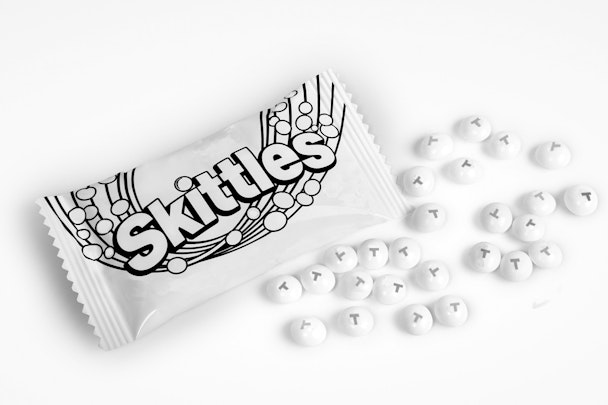Brand purpose skeptics take a ‘very different story’ from Peter Field’s IPA study
The methodology and findings of recently-released research from Peter Field and the Institute of Practitioners in Advertising (IPA) exploring the effectiveness of brand purpose marketing campaigns have been criticized by several prominent marketing industry strategists – underlining the intense debate still occurring around this hot topic.

Skittles is among the ‘well-executed’ brands in purpose
Among critics was behavioral specialist Richard Shotton, who has drawn quite a different conclusion into the viability of purpose-led marketing from the data.
The study compared and contrasted 47 brand purpose cases with 333 non-purpose cases over the same period. 57% of brand purpose campaigns studied were deemed to “perform strongly.” These “well-executed” campaigns drove 15% more market share growth than standard ad campaigns, a fact many fans of purpose have grasped on to and championed.
Field’s claims were more grounded, however. He claims the research merely proves that “we shouldn’t dismiss brand purpose out of hand” and that there can be “considerable benefits for companies in deploying brand purpose campaigns.”
The press release opened with the following sentence: “Blanket criticisms of brand purpose advertising are unjustified, according to effectiveness expert Peter Field.” The research itself has garnered blanket criticisms instead.
Proponents of brand purpose campaigns point out that there is more to offer than marketing effectiveness alone. It arguably helps build positive company culture, attract passionate talent and deliver extra media attention. This was all outlined in Sam Scott’s column this week exploring the nuances and benefits of brand purpose.
The IPA research in question, which you can read a summary of here, was criticized by Choice Factory author Richard Shotton, who posted a so-called Twitter ‘rant’ to show some the shortcomings.
He tweeted: “There are quite a few headlines in the trade press today about the effectiveness of purposeful ads. However, the actual data tells a very different story... The research is based on analysis of the IPA effectiveness Databank and it compares ads with a purpose with those without one.”
That the research focused on “a subset of purpose ads – the well-executed ones [v] all non-purposeful ads,” skewed any conclusions in favor of purpose. He adds. “If you look at the remaining purposeful ads – the poorly-executed ones – they actually perform worse than general ads.”
The research acknowledged this: “Badly-executed purpose campaigns performed worse than non-purpose brand campaigns.” None of these drove significant market share, and only 5% drove customer acquisition.
The study’s use of “well-executed” ads offered “a statement of circular logic,” Shotton says. He claimed that any subset of “well-executed” ad [his example was orange-colored ads but it could just as easily be ads that use rock music] would always outperform average ads. “The thing that drives that overperformance is the fact you are only looking at well-executed ads.”
He urged marketers to look at the outcome of comparisons of “all-purpose ads v all non-purpose ads,” which showed that purpose-based ads were less effective than the average non-purpose campaign. This suggests that purpose ads require real commitment from advertisers in order to provide marketing benefits.
Shotton compared one headline published in the trade press discussing the “well-executed ads” findings as “focusing on the great buffet selection but relegating the iceberg to passing mention” on the Titanic’s maiden voyage.
Shotton’s long been trying to temper the excitement around brand purpose campaigns. In 2018, he pinpointed: “Marketers have fallen out of love of marketing for marketing’s sake. The art of buying and selling things and creating good products is now widely seen as an unethical career and try to make up for it by balancing it with brand purpose.”
There were more responses to the report, whose findings split adland.
First, there was an apt analogy from columnist Mark Ritson: “Premier League analysts have been looking at football data in an attempt to prove left-footed players score more goals than their right-footed rivals. The initial data set, however, suggested lefties actually scored significantly less often.
“But everything changed when analysts focused on just the top-scoring left-footers in the league. Then, would you believe it, their performance was significantly superior to right-footed players. Proof that left-footed players score more than right-footed players.”
Thom Binding, head of creative strategy EMEA at Essence, summed up how many feel about purpose advertising. “As anticipated, we are willing these headlines to be true, which says a lot more about us and our world view than the purpose of advertising.” He also offered a “shameless plug” to his own thoughts defending brand purpose.
Simon McEvoy, UK head of strategy and UX at Omobono, said: “The idea that we can just remove the data that disproves the point we’re trying to make is a statistical own goal.”
And Giles Edwards, founder of Gasp, outlined the downfall of many of the non-well-executed purpose campaigns: “In my experience too many are trying to force the brand purpose-shaped piece through the commercial purpose-shaped hole.”
Methodology spats aside, the research shows there is a noticeable uplift from a well-executed purpose campaign, but there’s greater risk involved... the public is savvy to duds.

